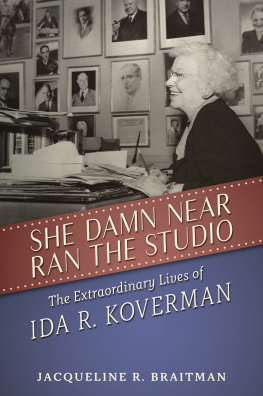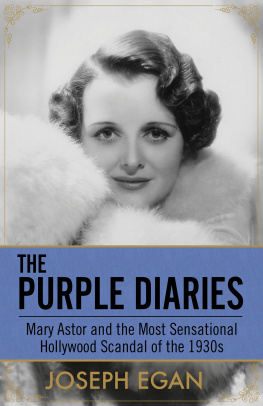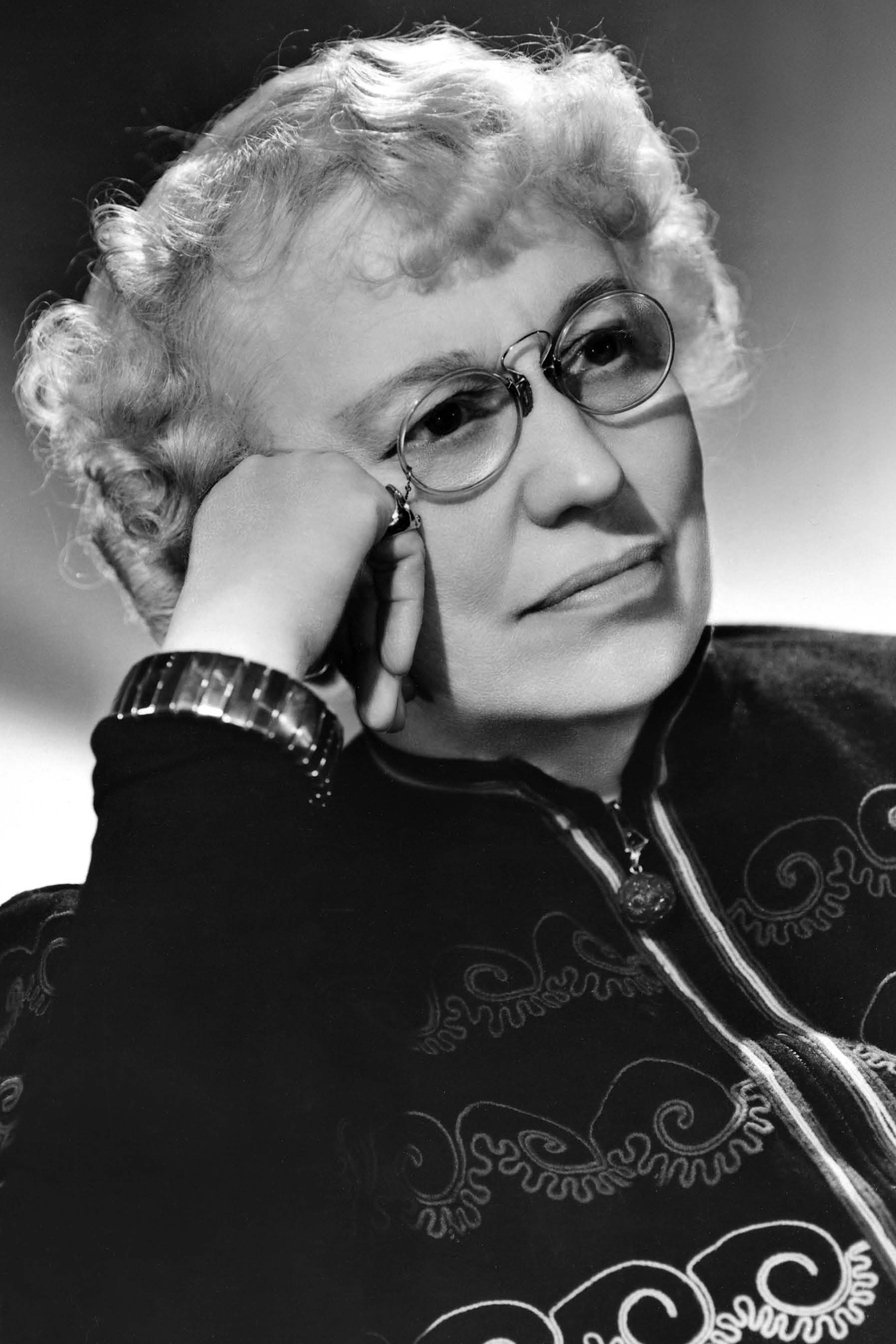Contents
Page List
Guide
SHE DAMN NEAR RAN THE STUDIO
HOLLYWOOD LEGENDS SERIES
CARL ROLLYSON, GENERAL EDITOR
SHE DAMN NEAR RAN THE STUDIO
The Extraordinary Lives of
Ida R. Koverman
JACQUELINE R. BRAITMAN
The University Press of Mississippi is the scholarly publishing agency of
the Mississippi Institutions of Higher Learning: Alcorn State University,
Delta State University, Jackson State University, Mississippi State University,
Mississippi University for Women, Mississippi Valley State University,
University of Mississippi, and University of Southern Mississippi.
www.upress.state.ms.us
Designed by Peter D. Halverson
The University Press of Mississippi is a member
of the Association of University Presses.
Copyright 2020 by Jacqueline R. Braitman
All rights reserved.
Manufactured in the United States of America
Photographs are courtesy of the author unless otherwise noted.
First printing 2020
Library of Congress Cataloging-in-Publication Data
Names: Braitman, Jacqueline R., 1953 author.
Title: She damn near ran the studio : the extraordinary lives of Ida R.
Koverman / Jacqueline R. Braitman.
Other titles: Hollywood legends series.
Description: Jackson : University Press of Mississippi, 2020. | Series:
Hollywood legends series | Includes bibliographical references and
index.
Identifiers: LCCN 2020017820 (print) | LCCN 2020017821 (ebook) | ISBN
9781496806192 (hardback) | ISBN 9781496830371 (epub) | ISBN
9781496830364 (epub) | ISBN 9781496830388 (pdf) | ISBN 9781496830395
(pdf)
Subjects: LCSH: Koverman, Ida R., 18761954Biography. |
Metro-Goldwyn-MayerHistory. | Motion picturesUnited StatesHistory.
Classification: LCC PN1998.3.K684 B73 2020 (print) | LCC PN1998.3.K684
(ebook) | DDC 791.43092 [B]dc23
LC record available at https://lccn.loc.gov/2020017820
LC ebook record available at https://lccn.loc.gov/2020017821
British Library Cataloging-in-Publication Data available
For Sara, Susan, Mom, and Tim
CONTENTS
PREFACE
SHE DAMN NEAR RAN THE STUDIO!
TURN ON ANY CLASSIC MOVIE CHANNEL AND YOU WILL SEE SCORES of films that have brought the hand of Ida R. Koverman into millions of homes for generations. An internet search results in hundreds of listings, and targeting historical newspapers brings even more, including one 1935 article claiming, When it comes to women executives, Ida Koverman seems to stand alone.1 Ida R. Koverman was a talent scout, mentor, executive secretary, and confidant to the vice president of Metro-Goldwyn-Mayer, movie mogul Louis B. Mayer. Viewed as the power behind Mayers throne, at times, she was considered the most powerful woman in Hollywood during the 1930s and 1940s, the golden era of the Metro-Goldwyn-Mayer studio. Nevertheless, only smatterings of biographical sketches have been written about her, and much of it is unfounded, unexamined, and untruethat is, until now. Because specialized fields of inquiry perceive the past through narrow lenses, a full portrait of Ida Kovermans compartmentalized lives have remained just beyond the field of vision looking at diverse aspects of Hollywood history. The sequential nature of her reincarnations is only visible through a prism that reflects the broader spectrum of California women in partisan politics and its symbiosis with the rising motion-picture industry, and MGM in particular.
Ida Koverman is a fixture in the history of MGM and some of Hollywoods most colorful characters. She has appeared as a minor character in theatrical and television productions about actresses Judy Garland, Greta Garbo, and gossip columnists Hedda Hopper and Louella Parsons. One of Kovermans colleagues, however, suggested that, while the legacies of Hopper and Parsons persist, Ida Kovermans name was not known to the public as much as these were but I would say she had more influence.2
Nevertheless, this is the first full account of the mysterious puzzle of Ida Kovermans extraordinary life, a long one lived in distinct incarnations, each segment of it invisible to the others. There were few raw materials on which to build a comprehensive narrative, but it grew from disparate pieces that eventually led to revelations of what are clearly sequential demarcations of her personal existence, each with layers of larger historical themes embedded within. This seminal account thus begins as a story within a story, and when viewed as part of the whole, it makes explicable why biographers have failed to look beyond the surface or to challenge what appears to have been a conscious effort to shroud her past in a mythical portrait.
A national financial scandal surfaced in 1909 that soon forced her to give up her life in Cincinnati, Ohio. She escaped and reinvented herself in New York during a decade that would inspire the origin story that has survived to this day. After the first world war, her next incarnation came in Southern California, where she capitalized on the major transformations of the regionchanging demographics, partisan politics, and popular cultural. She established herself as a hardcore political operative, a kingmaker, and as such was the matchmaker for the growing motion-picture industry and the state Republican Party. This led to her partnership with a growing network of professional women, the citys elites, and Louis B. Mayer, who facilitated her most visible and last incarnation in her elevated perch at MGM. Soon she became the studios premiere star maker, bringing talent to or nurturing the careers of the biggest stars, and she became one of the invisible power centers in both MGM and the city of Los Angeles.3
This work offers new perspectives about well-known figures in Hollywood and politics, but when viewed in proximity to Ida Koverman, their context takes on new historical meanings. This includes a network of men and women whose alliance with Ida Koverman shaped public policy, political power, and popular culture. Recent interest in women, in and out of power, in Hollywood and beyond, makes Ida Koverman a timely subject, and she fits neatly into distinct scholarly analyses that look at the rise of the Hollywood-Washington connection and the rise of twentieth-century conservative political movements.4 Regarding the first, this work places Ida Koverman at the center and not in the shadow of Louis B. Mayer in facilitating the marriage of politics and pictures, and it pushes the roots of modern conservatism back to the immediate post World War I years when Ida R. Koverman planted herself in the Golden State. The early chapters were first drafted during the 2016 presidential primary season when, just as in 1920, the Republican Party candidates reflected similar ideological factions that threatened the very soul of the party. Whats more, the outcome of the general election epitomized the fruition of a century of the evolution of celebrity politics, enabled by the media technology and tactics first employed by Ida Kovermans tenure in partisan politics and motion pictures.
There are only a handful of files in even fewer archives to form the basis of a full portrait of Ida Koverman. There are no collections of Ida Kovermans papers, diaries, or published memoirs. Any knowledge about her life and legacy rests on consistent references to a catalogue of scholarly and popular works about Hollywood and the talent and executives of Metro-Goldwyn-Mayer studio. Bosley Crowther noted in his 1960











